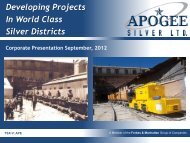Pulacayo Project Feasibility Study - Apogee Silver
Pulacayo Project Feasibility Study - Apogee Silver
Pulacayo Project Feasibility Study - Apogee Silver
You also want an ePaper? Increase the reach of your titles
YUMPU automatically turns print PDFs into web optimized ePapers that Google loves.
<strong>Pulacayo</strong> 1 000 t/d Phase I <strong>Feasibility</strong> <strong>Study</strong> - NI 43-101 Technical Report<br />
090644-3-0000-20-IFI-100<br />
17.1.1 Crushing Area<br />
Run of mine ore will be delivered from the underground mine to the process plant via<br />
Gramby self-dumping cars through a railway system. The crushing area is situated on<br />
surface 1.43 km from the adit. The ore is moved from the adit to the crushing area and<br />
dumped onto a fixed grizzly with 400 mm bar spacings and into the coarse ore bin. Oversize<br />
rock is broken by a JCB backhoe with a rock breaker attachment. Since the ore comes from<br />
relatively small stopes, most of the rock is expected to be smaller than 500 mm.<br />
From the 40 t coarse ore bin, ore is moved by a 6,600 mm by 760 mm apron feeder directly<br />
into the primary jaw crusher. The primary crusher, a 500 mm by 750 mm single toggle jaw<br />
type with a close side setting gap of 50 mm and installed with a 75 kW de-rated motor. The<br />
crushed ore is discharged to a belt conveyor. A self-cleaning moving belt magnet and<br />
fixed/static magnet on this belt removes tramp iron and a metal detector trips the belts<br />
protecting the secondary cone crusher from tramp metal such as rock bolts or steel balls.<br />
The conveyor belt dumps directly onto a 4,800 mm by 1,800 mm double deck primary<br />
vibrating screen. The primary screen is provided with an upper deck screen of 25 mm and a<br />
lower deck screen of 12 mm. Both screens oversize fractions pass through a secondary<br />
cone crusher with a close side setting of 12 mm and equipped with a 200 kW de-rated<br />
motor. Both screen decks have polyurethane screen panels, polyurethane weir bars spaced<br />
at 900 mm intervals and four bar pressure spray nozzles wash the clays off the rock<br />
particles. The 1,300 mm diameter cone crusher discharges onto conveyor belt from where it<br />
is combined with the jaw crusher discharge and is returned to the screen (i.e. the cone<br />
crusher is in closed circuit with the vibrating screen). Another alternative has also been<br />
considered in which the primary screen is being replaced by a scrubber with a trommel at<br />
the discharge end. The scrubber discharge goes to the secondary double deck screen while<br />
the oversize material goes to the cone crusher. This option will be studied further during the<br />
detail engineering stage.<br />
The primary screen undersize bypasses the second stage cone crusher and feeds directly<br />
onto the 4,800 mm by 1,800 mm double deck vibrating screen. Both screen decks have<br />
polyurethane screen panels, polyurethane weir bars spaced at 900 mm intervals and four<br />
bar pressure spray nozzles wash the clays off the rock particles. The dewatering screen will<br />
have an upper deck screen of 6.5 mm and a lower deck screen of 0.4 mm. Oversize<br />
fractions from the screen are transported to the two 1,000 t fine ore storage bins by a belt<br />
conveyor. This crushed product has a nominal top size of 12 mm, 85% +6.5 mm and 14.5%<br />
+0.4 mm.<br />
Undersize fraction is directed to an in-line strainer (Tekleen filter, 600 kPa in-line pressure)<br />
to retain the clayish material to clarify the water that will be used again in the circuit (high<br />
pressure spray water and hosing water). The clayish fraction is directed to the ball mill<br />
discharge pump box (or back to the dewatering screen if required).<br />
The design operating rate for the crushing plant is of 83.3 t/h. At 1,000 t/d, the crushing plant<br />
requires 12 hours per day operating time. The crushing circuit feeds (2) parallel milling<br />
circuits (1 and 2) of the same design capacity.<br />
TWP Sudamérica S.A. Av. Encalada 1257 Of. 801, Santiago de Surco Lima 33, Perú (51-1) 4377473<br />
Page 172



